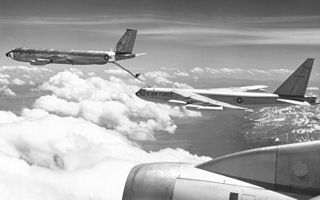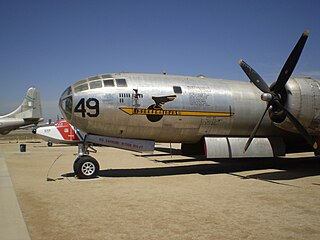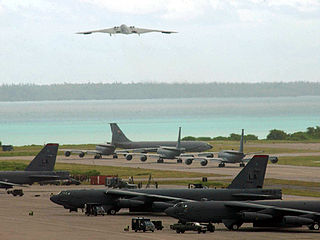
The 499th Air Refueling Wing is an inactive United States Air Force (USAF) unit that was last active at Westover AFB, Massachusetts in June 1966.

The 497th Air Expeditionary Group is a provisional United States Air Force unit. It is assigned to Pacific Air Forces to activate or inactivate as needed.

The 500th Air Expeditionary Group is a provisional United States Air Force unit. Its last known assignment was at Christchurch, New Zealand, where it was activated for the summer 2005–2006 season.

The 73d Air Division is an inactive United States Air Force unit. Its last assignment was with Air Defense Command at Tyndall Air Force Base, Florida, where it was inactivated on 1 April 1966.

The 444th Air Expeditionary Wing is a provisional unit of the United States Air Force assigned to Air Combat Command to activate or inactivate as needed. It was last activated in 2003.

The 462d Air Expeditionary Group is a provisional unit of the United States Air Force. It is assigned to Air Mobility Command to activate or inactivate as needed to meet operational requirements. Its last assignment was at Naval Support Facility Diego Garcia, British Indian Ocean Territory.

The 494th Air Expeditionary Group is a provisional United States Air Force group assigned to Air Mobility Command (AMC) to activate or inactivate as needed. The group was activated in the events surrounding Operation Iraqi Freedom, the 2003 United States invasion of Iraq. Now-Lieutenant General Stayce D. Harris is listed by the USAF as commanding the 494th AEG at Moron Air Base, Spain, from July to October 2003. In addition, a patch published at USAF Patches.com implies that the group was active in Spain during "Iraqi Freedom."

The United States Air Force's 10th Intelligence Support Squadron is an intelligence unit located at Langley Air Force Base, Virginia.

The 24th Expeditionary Reconnaissance Squadron is a provisional unit of the United States Air Force. It is assigned to United States Air Forces Europe to activate or inactivate as needed. Its last known attachment was to the 100th Air Refueling Wing, stationed at RAF Mildenhall, Suffolk, UK in 2007.

The 497th Bombardment Group was a group of the United States Army Air Forces. The unit was inactivated on 31 March 1946.

The 883d Bombardment Squadron is a former United States Army Air Forces unit. It was organized in November 1943 and, after training in the United States, deployed to the Pacific Ocean Theater of World War II, where it participated in the strategic bombing campaign against Japan. It earned two Distinguished Unit Citations before the end of the war. It returned to the United States in the fall of 1945 and was inactivated at March Field, California in January 1946.

The 882d Bombardment Squadron is a former United States Army Air Forces unit. It was organized in November 1943 and, after training in the United States, deployed to the Pacific Ocean Theater of World War II, where it participated in the strategic bombing campaign against Japan. It earned two Distinguished Unit Citations before the end of the war. The squadron returned to the United States in the fall of 1945 and was inactivated at March Field, California in January 1946.

The 877th Bombardment Squadron is a former United States Army Air Forces unit. It was activated in November 1943, equipped with Boeing B-29 Superfortress bombers, and assigned to the 499th Bombardment Group. After training in the United States, it deployed to Saipan, where it participated in the strategic bombing campaign against Japan, earning two Distinguished Unit Citations. After V-J Day, it returned to the United States, where it was inactivated at March Field, California on 16 February 1946.

The 878th Bombardment Squadron is a former United States Army Air Forces unit. It was activated in November 1943, equipped with Boeing B-29 Superfortress bombers, and assigned to the 499th Bombardment Group. After training in the United States, it deployed to Saipan, where it participated in the strategic bombing campaign against Japan, earning two Distinguished Unit Citations. After V-J Day, it returned to the United States, where it was inactivated at March Field, California on 16 February 1946.

The 879th Bombardment Squadron is a former United States Army Air Forces unit. It was activated in November 1943, equipped with Boeing B-29 Superfortress bombers, and assigned to the 499th Bombardment Group. After training in the United States, it deployed to Saipan, where it participated in the strategic bombing campaign against Japan, earning two Distinguished Unit Citations. After V-J Day, it returned to the United States, where it was inactivated at March Field, California on 16 February 1946.

The 40th Expeditionary Bomb Squadron is a provisional United States Air Force unit. It was assigned to the 40th Air Expeditionary Wing, possibly stationed at Diego Garcia. Its current status is unknown.

The 872nd Bombardment Squadron is the former name of the 872nd Air Expeditionary Squadron, a provisional unit of the United States Air Force. It is assigned to United States Air Forces Europe to activate or inactivate as needed.

The 869th Bombardment Squadron is a former United States Army Air Forces unit. It was assigned to the 497th Bombardment Group, and was last stationed at MacDill Field, Florida where it was inactivated on 31 March 1946. The squadron was activated in late 1943. After training in the United States, it moved to Saipan in the Central Pacific Area, where it served in the strategic bombing campaign against Japan with Twentieth Air Force, flying Boeing B-29 Superfortress aircraft, where it earned two Distinguished Unit Citations. Following V-J Day, the squadron returned to the United States and briefly became part of Strategic Air Command before inactivating.

The 870th Bombardment Squadron is a former United States Army Air Forces unit. It was assigned to the 497th Bombardment Group, and was last stationed at MacDill Field, Florida where it was inactivated on 31 March 1946. The squadron was activated in late 1943. After training in the United States, it moved to Saipan in the Central Pacific Area, where it served in the strategic bombing campaign against Japan with Twentieth Air Force, flying Boeing B-29 Superfortress aircraft, where it earned two Distinguished Unit Citations. Following V-J Day, the squadron returned to the United States and briefly became part of Strategic Air Command before inactivating.

The 875th Bombardment Squadron is a former United States Army Air Forces unit. The squadron was activated in late 1943 for service during World War II. After training in the United States with Boeing B-29 Superfortress bombers, the squadron moved to the Mariana Islands, where it participated in the strategic bombing campaign against Japan, earning two Distinguished Unit Citations before the end of hostilities in August 1945. The squadron returned to the United states in December 1945 and was inactivated in March 1946, and its personnel and equipment transferred to another organization.





















